Global Sterilization Pouches Market Size and Trends
The sterilization pouches market is estimated to be valued at USD 40.25 Bn in 2025 and is expected to reach USD 62.99 Bn by 2032, growing at a compound annual growth rate (CAGR) of 6.6% from 2025 to 2032.
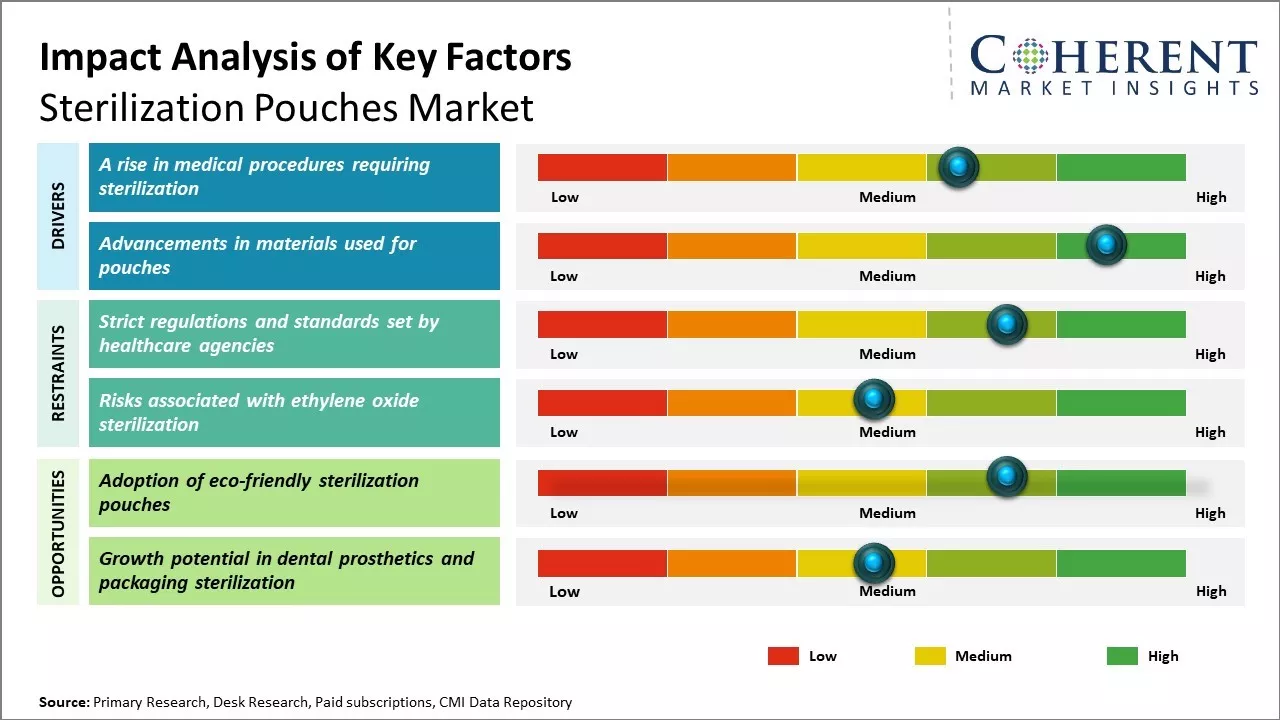
Discover market dynamics shaping the industry: Download Free Sample
The sterilization pouches market is expected to witness significant growth over the forecast period. The increasing focus on minimally invasive surgeries and demand for pre-sterilized medical devices are some key factors that are expected to drive the demand for sterilization pouches. Moreover, advancements in sterilization technologies aimed at improving the safety and efficacy of sterilization processes are also projected to support the market growth. However, availability of alternative sterilization methods may restraint the market growth to a certain extent. Overall, growing concerns regarding hospital acquired infections coupled with an increasing volume of surgical procedures performed are expected to create lucrative opportunities for players in sterilization pouches market.
A rise in medical procedures requiring sterilization
With the increase in life expectancy and the aging population worldwide, there has been a significant rise in the number of medical procedures performed annually. Sterilization pouches are commonly used by hospitals and healthcare facilities for sterilizing and packaging medical devices that will be used during surgeries and other invasive procedures. The growing disease burden and rising healthcare expenditure in developing countries are also contributing to higher hospital admission rates and the use of medical devices. With more procedures being performed, the demand for reliable sterilization solutions like sterilization pouches is surging in tandem. Various factors such as the shortage of healthcare professionals and efforts to reduce hospital stay are further propelling ambulatory surgical centers and the usage of disposable medical devices packaged in sterilization pouches. The continuous rise in complex surgeries and the launch of new single-use devices will keep driving the need for sterilization pouches globally.
Market Concentration and Competitive Landscape
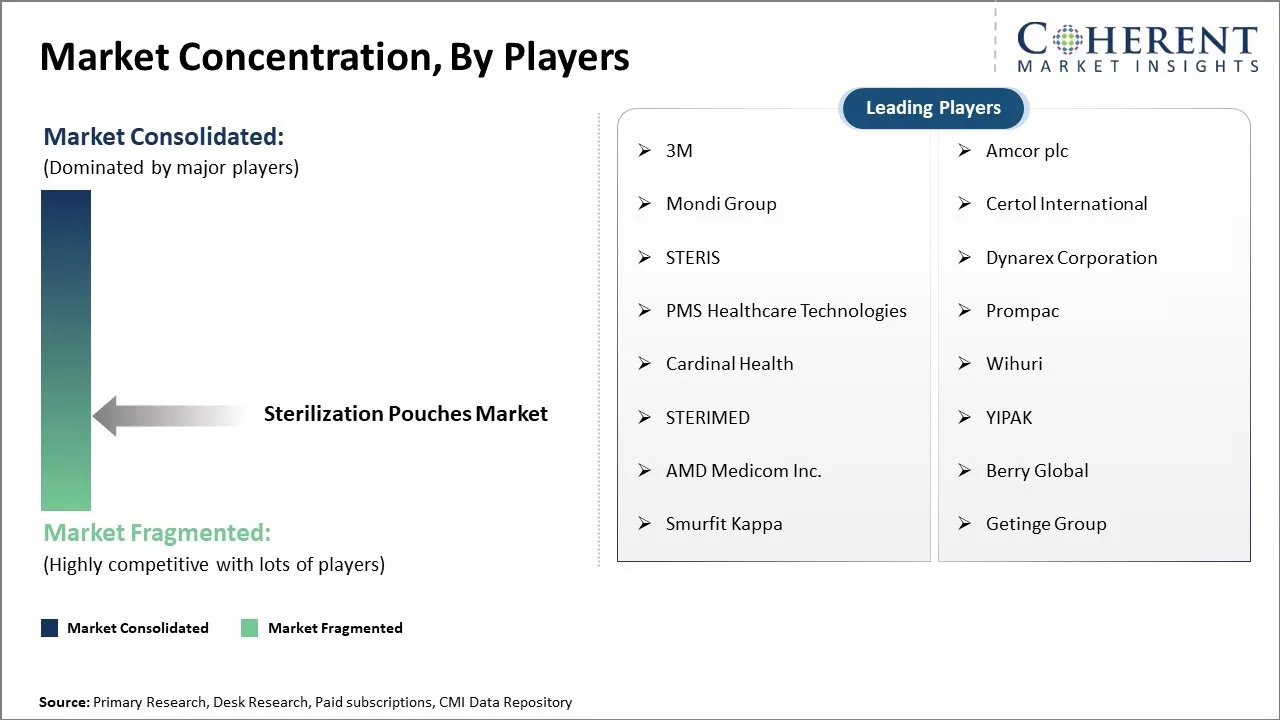
Get actionable strategies to beat competition: Download Free Sample
Advancements in materials used for pouchesOngoing research and development activities have led to significant advancements in the materials utilized for manufacturing sterilization pouches. The introduction of composite barrier films, coated non-wovens, and high-performance plastics have vastly enhanced the functionality and efficacy of sterilization pouches. The latest sterilization pouches offer high tensile strength, superior moisture vapor transmission, reliable barrier protection against microbes, and uniform heat distribution during sterilization. They also allow the efficient packaging of both delicate and rigid medical devices. The availability of user-friendly features like customizable sizes, tear-proof construction, wide temperature tolerance, and indicator strips for easy quality monitoring has increased the convenience for healthcare workers. Leading pouch manufacturers have also diversified their product portfolios with specialized pouches tailored for particular medical specialties or sterilization methods. The market is witnessing wider adoption of advanced materials-based sterilization pouches that provide enhanced protection and usability.
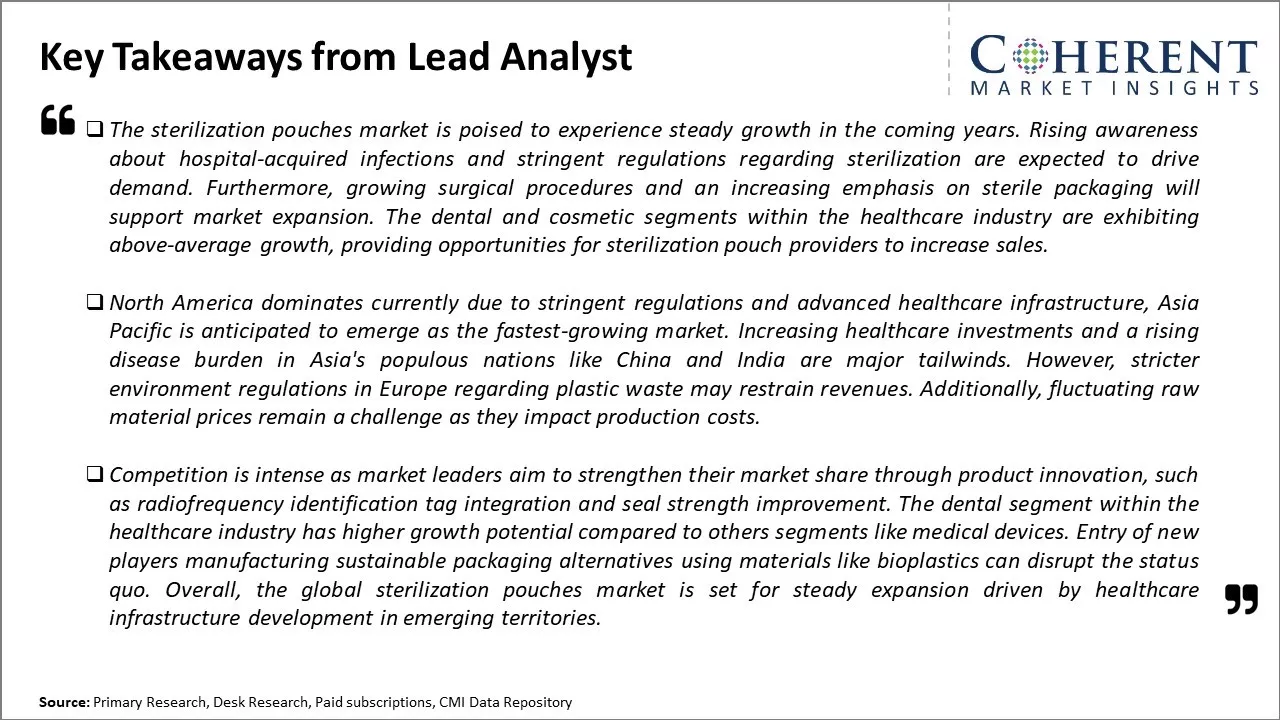
To learn more about this report, Download Free Sample
Market Challenges: Strict regulations and standards set by healthcare agenciesOne of the key challenges for the sterilization pouches market is ensuring the proper sterilization of medical devices packed in pouches. Strict regulations and standards set by healthcare agencies require pouches to prevent contamination and bacterial growth over extended periods of time. Additionally, fluctuations in raw material prices impact manufacturing costs. Pouches need to be highly permeable to steam and indicate effective sterilization through chemical indicators, which require continued research and innovation. Size and design limitations also affect the types of medical products that can be packed. Maintaining consistency in barrier properties across massive production volumes further challenges manufacturers.
Market Opportunities: Adoption of eco-friendly sterilization pouches
The sterilization pouches market has traditionally relied on non-biodegradable plastic materials that have negative environmental consequences. However, growing consumer awareness about sustainability and corporations' increased focus on environmental, social and governance (ESG) criteria are driving the demand for greener alternatives. Adopting eco-friendly sterilization pouches made from biodegradable and compostable materials could allow companies to tap into this market opportunity and boost their brand image.
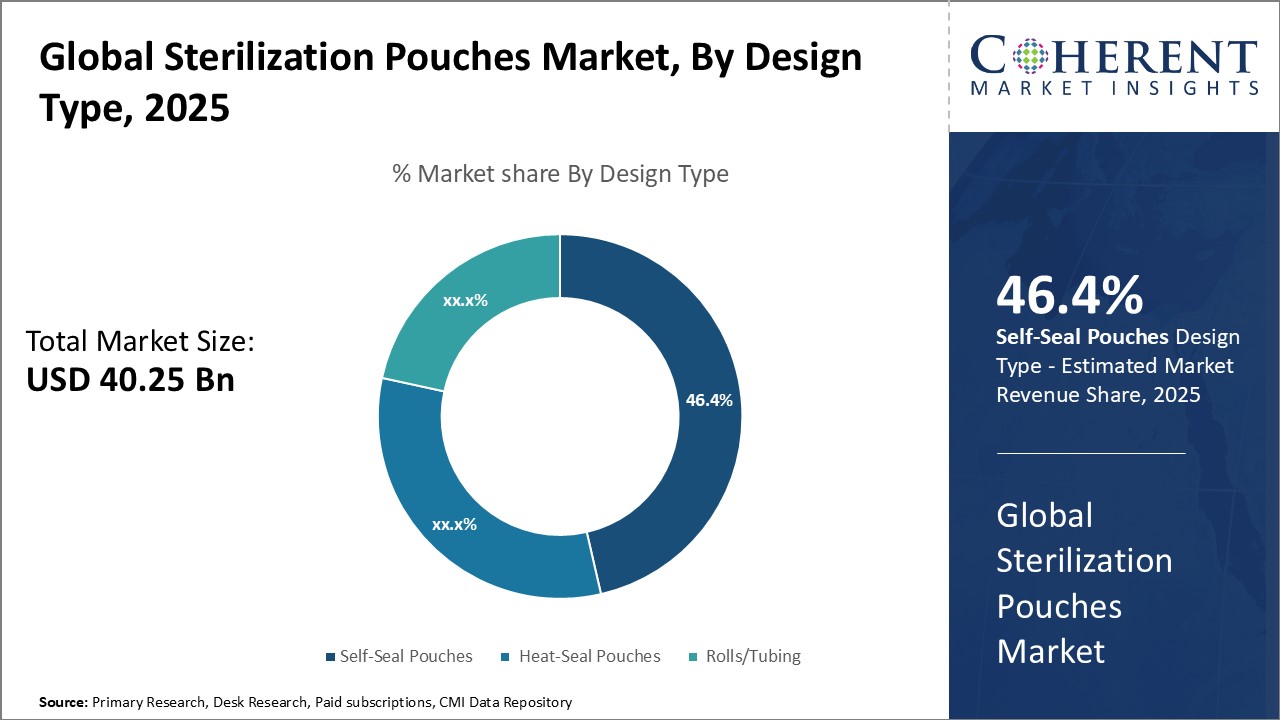
Discover high revenue pocket segments and roadmap to it: Download Free Sample
Insights, By Design Type: Convenience of Use Drives the Demand for Self-seal PouchesThe design type segment includes self-seal pouches, heat-seal pouches, and rolls/tubing. Self-seal pouches segment is anticipated to hold 46.4% of the market share in 2025. Self-seal pouches are pre-sealed on three sides, with an open end that allows contents to be easily inserted. Unlike heat-seal pouches which require heat-sealing equipment to seal the contents, self-seal pouches can be sealed manually just by applying pressure on the open end. This flip-top style of opening and sealing provides unmatched ease of opening and closing for healthcare professionals. Sterilization of medical instruments and supplies requires frequent opening and closing of pouches during the process. The hassle-free manual sealing mechanism of self-seal pouches saves precious time for overworked hospital staff. The convenience of self-seal pouches has made them especially popular in clinics and diagnostic centers where sterilization needs are more intermittent compared to hospitals. The absence of any specialized sealing machinery keeps the operational costs very low. This has increased their adoption in low budget healthcare facilities.
Insights, By Material Type: Durability of Paper/Plastic Laminates Boost the Demand for Paper/Plastic Material
The material type segment includes paper/plastic and tyvek/plastic. Paper/plastic contributed the highest share of the sterilization pouches market and is projected to hold 72.3% of the market share in 2025. Paper-plastic laminate provides optimum durability required for sterilization applications. Repeated exposure to high temperatures, moisture and mechanical stresses poses risk of delamination or breakage of seals in sterilization pouches. Paper on its own decomposes easily under heat, whereas plastic is prone to developing micro cracks due to brittleness. However, combining paper with plastic overcomes individual limitations of each material. The paper layer provides strength and barrier against punctures or tearing. It also allows legible printing of product identification details directly on the pouch surface. Meanwhile, the outer plastic layer encapsulates the paper creating a moisture and vapor proof seal. This protects the contents from external contamination and prevents decomposition of the paper under heat.
Insights, By End User: High Patient Footfall Drives the Hospital Segment Development
The end user segment includes hospitals, clinics, diagnostics laboratories, and others. Hospitals contributed the highest share of the sterilization pouches market and is projected to hold 44.3% of the market share in 2025. Surgical departments in hospitals handle critical medical devices and instruments that require sterilization before every use to prevent nosocomial infections. Regulatory standards like the Centers of Disease Control guidelines impose strict compliance requirements on hospitals regarding sterilization practices. They necessitate the use of validated sterilization pouches that can withstand sterilization cycles without comprising the asepsis of packaged items. Compared to clinics and diagnostic centers, the higher volume of surgeries and broader treatment profiles in hospitals warrant larger stocks of sterilized inventory. Pouches sourced from reputed manufacturers assure performance consistency mandated for high-risk supplies. Their premium quality seals and durable laminates lower the risks of sterility failure which can prove financially devastating for hospitals through litigation costs or loss of patient goodwill. While price conscious, hospitals prioritize reliability of certified pouches to ensure patient safety. This makes hospital end users the largest adopters and stabilizes their stronghold in the sterilization pouch end user segment.
Regional Insights
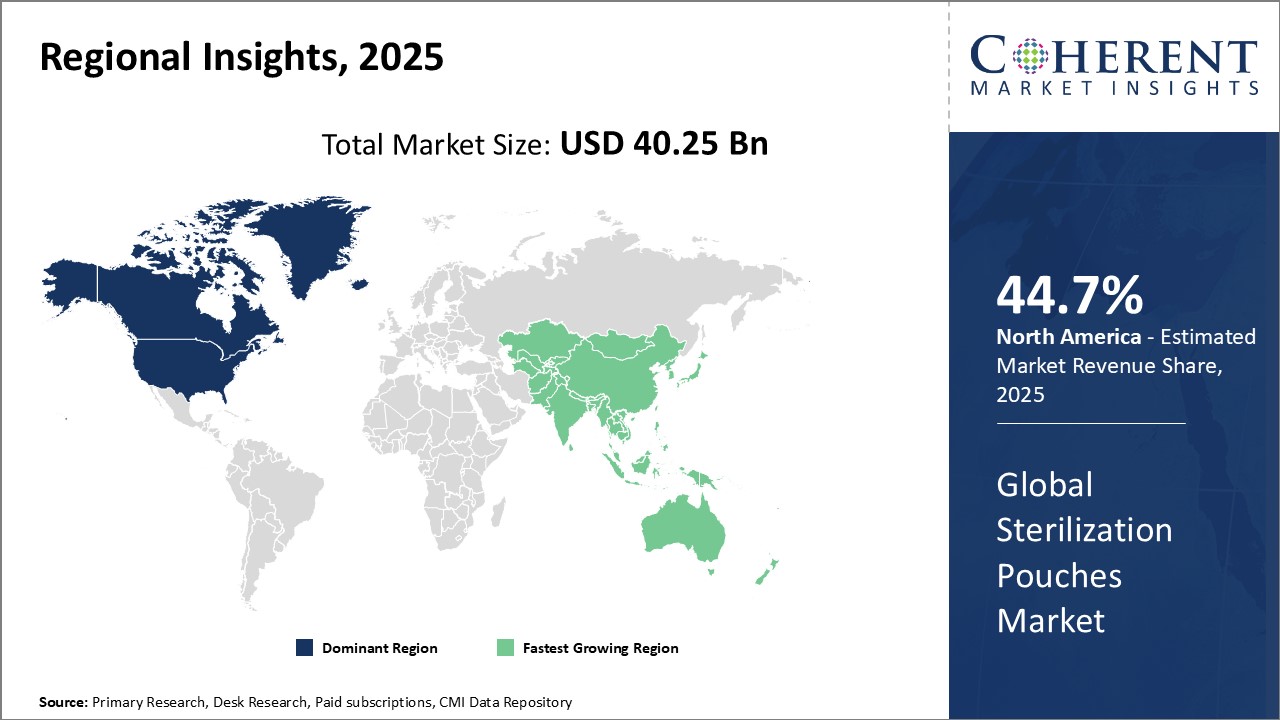
Need a Different Region or Segment? Download Free Sample
North America has established itself as the dominant region in the sterilization pouches market and is anticipated to hold 44.7% of the market share in 2025. With the presence of key industry players and well-established healthcare infrastructure, the U.S. accounts for the major market share. Stringent regulatory standards regarding sterility and quality have propelled demand over the years. Surgical procedures in the region are growing annually, fueled by rising disease incidence and the shift toward minimally invasive methods. This keeps generating the need for sterile packaging of medical instruments and devices across hospitals, clinics as well as ambulatory care centers. The demand for custom pouches with specific features further validates North America's supremacy.
Asia Pacific has emerged as the fastest expanding market for sterilization pouches globally. Countries like China, India, Japan, and South Korea are at the forefront, supported by economic development, increasing health expenditures, and a growing focus on public healthcare. The healthcare infrastructure is rapidly improving across developing nations. The large patient pool afflicted by both communicable and lifestyle diseases has enhanced the volume of surgeries and therapeutic applications. This expands the customer base for sterilization pouches for medical equipment and pharmaceuticals. Additionally, lower manufacturing costs have made Asia Pacific an attractive production hub for key players. Local companies are also establishing themselves by offering high-quality products at competitive rates. Rising medical tourism in the region further stokes market growth.
Market Report Scope
Global Sterilization Pouches Market Report Coverage
| Report Coverage | Details | ||
|---|---|---|---|
| Base Year: | 2024 | Market Size in 2025: | USD 40.25 Bn |
| Historical Data for: | 2020 To 2024 | Forecast Period: | 2025 To 2032 |
| Forecast Period 2025 to 2032 CAGR: | 6.6% | 2032 Value Projection: | USD 62.99 Bn |
| Geographies covered: |
|
||
| Segments covered: |
|
||
| Companies covered: |
3M, Amcor plc, Mondi Group, Certol International, STERIS, Dynarex Corporation, PMS Healthcare Technologies, Prompac, Cardinal Health, Wihuri, STERIMED, YIPAK, AMD Medicom Inc., Berry Global, Smurfit Kappa, and Getinge Group |
||
| Growth Drivers: |
|
||
| Restraints & Challenges: |
|
||
Uncover macros and micros vetted on 75+ parameters: Get instant access to report
Global Sterilization Pouches Industry News
- On January 24, 2024, Cherwell, a cleanroom microbiology solutions provider, launched the Redipor Beta Bag to allow the safe transfer of ready-to-use gamma-irradiated prepared media into sterile production environments. This innovative multiple-use product transfer bag has the potential to minimize risk, cost, and time in environmental monitoring (EM) operations used in the continuous manufacturing of sterile medicinal products.
- In May 2023, Ahlstrom, a fiber-based product manufacturer, expands its portfolio for the medical industry with the introduction of Reliance Fusion, a next-generation simultaneous sterilization wrap that helps hospitals improve the efficiency of sterilizing surgical equipment trays. Sterilization wraps are widely used in healthcare facilities around the world to keep surgical tools sterile.
- In March 2023, Sterimed Group, a global leader in medical packaging through its U.K. subsidiary Westfield Medical, announced the completion of the acquisition of Granton Medical, a leading manufacturer of sterilization pouches and provider of packing services to the medical device industry in the UK. Granton Medical has risen to become the largest manufacturer of self-seal pouches for sterilizing centers and hospitals in the U.K.
- In December 2021, Sterimed Group announced that it has completed the acquisition of Westfield Medical, a major supplier of sterilizing packaging systems based in the U.K. Westfield Medical has been in business for almost 45 years and has a significant market presence in the U.K. and abroad, with a comprehensive product range for hospitals and medical device manufacturers. The company manufactures sterilization pouches, reels, bags, wraps, and tray liners at its facility near Bristol, U.K.
*Definition: The sterilization pouches market involves packaging solutions that are used to sterilize medical devices and surgical instruments. Sterilization pouches are made of permeable materials that allow sterilization gases like ethylene oxide to pass through during the sterilization process, killing any microbes inside the pouch and on the packaged item. They provide barrier protection and maintain sterile conditions for packaged items during transportation and storage until use.
Market Segmentation
- Design Type Insights (Revenue, USD BN, 2020 - 2032)
- Self-Seal Pouches
- Heat-Seal Pouches
- Rolls/Tubing
- Material Type Insights (Revenue, USD BN, 2020 - 2032)
- Paper/Plastic
- Tyvek/Plastic
- End User Insights (Revenue, USD BN, 2020 - 2032)
- Hospitals
- Clinics
- Diagnostics Laboratories
- Others
- Regional Insights (Revenue, USD BN, 2020 - 2032)
- North America
- U.S.
- Canada
- Latin America
- Brazil
- Argentina
- Mexico
- Rest of Latin America
- Europe
- Germany
- U.K.
- Spain
- France
- Italy
- Russia
- Rest of Europe
- Asia Pacific
- China
- India
- Japan
- Australia
- South Korea
- ASEAN
- Rest of Asia Pacific
- Middle East
- GCC Countries
- Israel
- Rest of Middle East
- Africa
- South Africa
- North Africa
- Central Africa
- North America
- Key Players Insights
- 3M
- Amcor plc
- Mondi Group
- Certol International
- STERIS
- Dynarex Corporation
- PMS Healthcare Technologies
- Prompac
- Cardinal Health
- Wihuri
- STERIMED
- YIPAK
- AMD Medicom Inc.
- Berry Global
- Smurfit Kappa
- Getinge Group
Share
Share
About Author
Manisha Vibhute is a consultant with over 5 years of experience in market research and consulting. With a strong understanding of market dynamics, Manisha assists clients in developing effective market access strategies. She helps medical device companies navigate pricing, reimbursement, and regulatory pathways to ensure successful product launches.
Missing comfort of reading report in your local language? Find your preferred language :
Transform your Strategy with Exclusive Trending Reports :
Frequently Asked Questions
EXISTING CLIENTELE
Joining thousands of companies around the world committed to making the Excellent Business Solutions.
View All Our Clients
